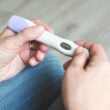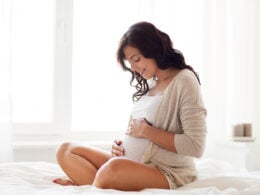Having a baby is a life-changing event, and, for some, it can feel like your life has been turned upside down. You’ve gone from anticipating the birth of your child to facing the prospect of caring for a tiny, new human being who is completely dependent on you for its survival. It’s understandable that new mothers often feel overwhelmed in the days, weeks, and months following the birth of their child. In fact, we have a name for what many women experience in the first few days after having a baby: the “baby blues.”
The baby blues affect up to 80 percent of mothers, according to the National Institute on Mental Health (NIMH) and are characterized by relatively mild feelings of being worried, unhappy, and fatigued for a period of no more than two weeks. However, some women, in addition to navigating the changes that a new baby brings, experience symptoms beyond the baby blues known as postpartum depression (PPD).
Postpartum depression symptoms are typically more severe than the baby blues, last longer than two weeks, and require treatment by a mental health professional. About 15 percent of mothers experience PPD, according to the NIMH, making it a very important issue to be aware of whether you are a new mom, or a family member or friend of someone who has a new baby. By increasing your own awareness of the signs and symptoms of postpartum depression, you can help those you love seek treatment as soon as possible in order to increase their chances of a full recovery more quickly.
Symptoms of Postpartum Depression
Many women who experience the symptoms of PPD feel guilty because, instead of experiencing the joys of being a new mom, they feel sad, worried, and overwhelmed along with a host of other symptoms. However, PPD is not caused by something a mother does or doesn’t do, according to NIMH. Instead, postpartum depression is most likely influenced by both physical and emotional factors ranging from hormonal changes to sleep deprivation. Women with PPD often begin experiencing symptoms one week to one month after giving birth (however, the symptoms may begin before childbirth in about half of PPD cases, according to the American Psychological Association).
Symptoms include:
- Feeling of sadness, hopelessness, and being overwhelmed
- Crying more than usual
- Worrying or feeling anxious
- Changes in mood including increased irritability, restlessness, or anger
- Changes in sleep including oversleeping or having difficulty falling asleep
- Difficulty concentrating, increased forgetfulness, and difficulty making decisions
- Loss of interest in activities once enjoyed
- Physical pain including headaches, digestive issues, and/or muscle pain
- Changes in appetite
- Isolating self from family and friends
- Feeling emotionally detached from the baby
- Doubting the ability to be an adequate caretaker
- Thoughts of self-harm or of harming the baby
Risk Factors of Postpartum Depression
Although the exact reasons why some women develop PPD and others don’t aren’t fully understood, researchers have identified some factors that might indicate an increased risk for developing PPD. The following are factors that increase a mother’s risk for developing postpartum depression:
- Hormone changes after childbirth
- Prior history of anxiety and/or depression
- A family history of depression or mental illness
- An increase in stress that could include financial or employment stressors
- Taking care of a challenging baby or a baby with special needs
- First-time mothers, young mothers, older mothers
- Emotional stressors such as the death of a family member or relationship stressors
- Isolation or lack of social support
- The inability to breastfeed or extreme difficulty with breastfeeding, especially when breastfeeding was the expectation
It’s important to note that, in about 50 percent of PPD cases, it was the woman’s first episode of depression; for this reason, it is important to be aware of other risk factors as well as the symptoms of postpartum depression so that treatment can be sought as early as possible.
Treatment Options for Postpartum Depression
Like most other mental health diagnoses, PPD is best treated with psychotherapy and, in some cases medication, according to NIMH, if the physician determines the medication is safe to take while breastfeeding (assuming the mother still wishes to breastfeed). Thanks to the early work of Dr. Katherina Dalton, and later on, studies conducted by the Pope Paul VI Institute, progesterone injections have long been used by doctors in the field of Natural Procreative Technology as an option for treating PPD. Progesterone injections have the benefit of being compatible with breastfeeding while rapidly improving PPD symptoms, sometimes within mere minutes of administration. In March 2019, the FDA approved brexanalone, a natural metabolite of progesterone, specifically for the treatment of PPD.
The National Alliance on Mental Illness (NAMI) emphasizes that early detection is key to successful treatment for PPD. Therefore, knowing the symptoms and risk factors for developing PPD, as well as working to remove the stigma around seeking treatment for mental health issues, are both very important. We need to continue to raise awareness surrounding postpartum depression in order to empower women to be aware of and seek treatment so that they don’t feel alone or unfairly blame themselves for their symptoms. Adjusting to taking care of a new baby while recovering from childbirth is challenging enough without coping with PPD. We all play a critical role in raising awareness and helping women seek treatment to help them feel like themselves again, so that they can embrace—and also enjoy—motherhood.











